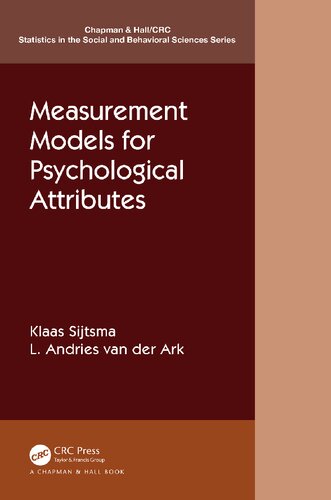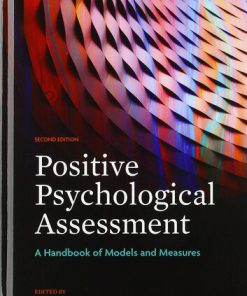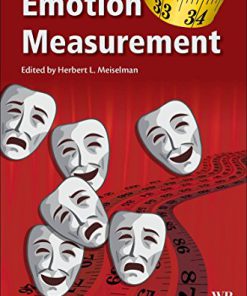Measurement Models for Psychological Attributes 1st Edition by Klaas Sijtsma 0429527292 9780429527296
$50.00 Original price was: $50.00.$25.00Current price is: $25.00.
Measurement Models for Psychological Attributes 1st Edition by Klaas Sijtsma – Ebook Instant Download/Delivery ISBN(s): 0429527292, 9780429527296

Product details:
- ISBN 10: 0429527292
- ISBN 13: 9780429527296
- Author: Klaas
Despite the overwhelming use of tests and questionnaires, the psychometric models for constructing these instruments are often poorly understood, leading to suboptimal measurement. Measurement Models for Psychological Attributes is a comprehensive and accessible treatment of the common and the less than common measurement models for the social, behavioral, and health sciences. The monograph explains the adequate use of measurement models for test construction, points out their merits and drawbacks, and critically discusses topics that have raised and continue to raise controversy. Because introductory texts on statistics and psychometrics are sufficient to understand its content, the monograph may be used in advanced courses on applied psychometrics, and is attractive to both researchers and graduate students in psychology, education, sociology, political science, medicine and marketing, policy research, and opinion research.
Table of contents:
1 Measurement in the Social, Behavioral, and Health Sciences
Introduction
Methodological Procedures and Psychometric Measurement Models
Relation of Measurement Model to Attribute Scale
Developing Attribute Theory Is Important
Measurement Instruments
Measurement Models
Scales of Measurement
Causes of Messy Data
A Scale for Transitive Reasoning
Cycle of Instrument Construction
This Monograph
2 Classical Test Theory and Factor Analysis
Historical Introduction
The Classical Test Model
Measurement Level and Norm Scores
Model Assumptions
Repeatability of Test Scores: Reliability
Methods for Estimating Reliability
Methods Commonly Used in Test-Construction Practice
Parallel-Test Method
Retest Method
Split-Half Method
Internal Consistency Method
Reliability Methods Based on One Test Administration
Method λ1
Method λ3
Method λ2
Method λ4
Method λ5
Method λ6
Greatest Lower Bound
Special Topics Concerning Methods λ1 through λ6 and the GLB
Mutual Relationships of Lower Bounds and Reliability
Discrepancy of Methods λ1 through λ6 and the GLB
Overestimation of Reliability in Real Data
Confidence Intervals
Reliability versus Measurement Precision
Traditional Methods
Alternative Methods and Special Topics
Constructing Scales in the Classical Test Theory Context
Corrected Item-Total Correlations and Oblique Multiple Group Method
Principal Component Analysis
Factor Analysis
Factor-Analysis Approach to Reliability
One-Factor Model
Multi-Factor Model
Real-Data Example: The Type D Scale14 (DS14)
Discussion
3 Nonparametric Item Response Theory and Mokken Scale Analysis
Introduction
Model of Monotone Homogeneity
Prerequisites
Definitions and Notation
Assumptions
Strictly and Essentially Unidimensional IRT
An Ordinal Scale for Person Measurement
Goodness-of-Fit Methods
Unidimensionality: Scalability and Item Selection
Local Independence
Monotonicity
Data Example: The Type D Scale14 (DS14) Revisited Using Nonparametric IRT
Model of Double Monotonicity
Goodness-of-Fit Methods
Method Manifest Invariant Item Ordering
Other Methods for Investigating Manifest Invariant Item Ordering
Reliability
Data Example: The Type D Scale14 (DS14) Continued
Discussion
4 Parametric Item Response Theory and Structural Extensions
Introduction
A Taxonomy for IRT Models
Some Basic IRT Models for Dichotomous Items
Guttman Model
Normal-Ogive Models
One-Parameter Logistic Model or Rasch Model
The Model, Separability of Parameters
Sufficiency and Estimation
Information Functions and Measurement Precision
Goodness-of-Fit Methods
The Rasch Paradox
Epilogue
Two and Three-Parameter Logistic Models
Some Basic IRT Models for Polytomous Items
Adjacent Category Models
Cumulative Probability Models
Continuation Ratio Models
Filling in the Taxonomy
IRT Models for Special Purposes
Linear Logistic Test Model
Generalized Rasch Model with Manifest Predictors
Multidimensional IRT Models
Data Example: Transitive Reasoning
Discussion
5 Latent Class Models and Cognitive Diagnostic Models
Introduction
Latent Class Model
An Example: Proportional Reasoning
Introduction
The Unrestricted Model
Restricted Models
Estimation
Goodness-of-Fit Methods
Ordered LCM and Testing Monotonicity in Nonparametric IRT
Data Example: Proportional Reasoning by Means of the Balance Scale
Discussion
Cognitive Diagnostic Model
An Example: Identifying Patients’ Disorder Profiles Using the MCMI-III
Introduction
Models
Estimation
Goodness-of-Fit Methods
Relationship to Nonparametric IRT
Data Example: Identifying Patients’ Disorder Profiles Using the MCMI-III
Discussion
General Discussion
6 Pairwise Comparison, Proximity, Response Time, and Network Models
People also search:
types of psychological models
average size of a model
measurement psychology definition
measurement psychology
psychological measurement examples
You may also like…
Education Studies & Teaching
Educational Measurement for Applied Researchers Theory into Practice 1st Edition Margaret Wu
Relationships & Lifestyle - Diet & Nutrition
Positive Psychological Assessment A Handbook of Models and Measures 2nd Edition Matthew W. Gallagher
Engineering - Industrial Engineering & Materials Science
Measurement Technology for Process Automation 1st Edition Anders Andersson 1351974483 9781351974486
Physics - Quantum Physics
Engineering
Religion & Spirituality - Islam
The Attributes of God in Islamic Thought Contemplating Allah 1st Edition Mansooreh Khalilizand
Engineering
Electromagnetic Composites Handbook Models Measurement and Characterization 2nd Edition Rick Moore












